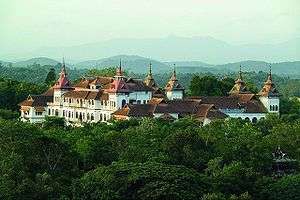Punnapra-Vayalar uprising
| Punnapra-Vayalar Uprising | |||||||
|---|---|---|---|---|---|---|---|
| Part of Communist Movements in Travancore against the Diwan | |||||||
 Memorial of Punnapra-Vayalar uprising martyrs located near Kalarcode, Alappuzha | |||||||
| |||||||
| Belligerents | |||||||
|
|
Laborers in Punnapra and Vayalar | ||||||
| Commanders and leaders | |||||||
| K. Kelappan | T. V. Thomas | ||||||
| Casualties and losses | |||||||
| Minor deaths | More than 1,000 people dead (Unconfirmed) | ||||||
The Punnapra-Vayalar uprising (October, 1946) was a communist uprising in the Princely State of Travancore, British India against the Prime Minister, C. P. Ramaswami Iyer and the state.[1] Communist Party members were killed by the army of the Diwan (Prime Minister), 200 people at Punnapra on 24 October and more than 150 at Vayalar on 27 October. The total loss of life is allegedly estimated to be more than a thousand.[1]
Historians like Prof Sreedhara Menon[2] (though one website claimed that he had retracted his views later[3]) maintain this was a proper struggle against the declaration of 'Independent Travancore' by the then Travancore government. The interpretation of this incident is still debated. Some people suggest certain Communist leaders instigated the coir workers belonging to the Ezhava community to wage a war against the then administration led by C. P. Ramaswami Iyer. T K Varghese Vaidya, a leader of the struggle, had gone on record saying it was a rehearsal for a larger revolution with the ultimate objective of establishing a "Communist India".
The region around Alleppey was a Communist stronghold and the communist workers organised a mass upheaval in October 1946 against the authority of the Diwan, and practically established their own government in the region. This led to attacks and deaths of Travancore police officials and government officials in that region. Dismayed by the turn of events, the Diwan declared martial law in Alleppy on 25 October 1946. The Travancore army moved from their camp and surrounded the communists at Vayalar by 27 October. The Travancore navy supported the army in isolating Vayalar, which is surrounded by water on three sides. Once the blockade was in place, the army moved in. It is estimated that at least 150 people were killed on the spot during the army's pincer movement on 27 October, and many more succumbed to injuries later. On the same day, at least 130 people were killed in army firings, elsewhere in the district. The local people and press maintain that many more people were killed and the bodies disposed by the army. Historians like A. Sreedhara Menon estimates that over a thousand people were killed during the Punnapra-Vayalar outbreak. Atrocities were not one sided, and there are reports of murders of Travancore policemen after they had surrendered to the communists, during the early stages of the disturbances. Police Inspector Velayudhan Nadar had moved forward to reason out with the communists, but he was brutally stabbed to death. This hardened the stance of the police and the armed forces. Following the suppression of the communist local governments, the Travancore police used heavy-handed methods to repress the political movement in the region and detained many activists without any trial.
After effects
The killings of communist comrades turned the Communists and even many non-communists totally against Iyer. When, on 3 June 1947, United Kingdom accepted demands for a partition and announced its intention to quit India within a short period, the Maharaja of Travancore desired to declare himself independent.[4][5][6] Supported by the Diwan, C. P., Chithira Thirunal issued a declaration of independence on 18 June 1947.[4][5][6] As Travancore's declaration of independence was unacceptable to India, negotiations were started with the Diwan by the Government of India.[7] Family sources indicate that C. P., himself, was not in favour of independence but only greater autonomy and that a favourable agreement had been reached between C. P. and the Indian representatives by 23 July 1947 and accession to the Indian Union could not be carried out only because it was pending approval by the Maharajah. Nevertheless, an assassination attempt was made on C. P. by a Brahmin youth named K.C.S. Mani who was an activist of the Socialist group led by N. Sreekantan Nair on 25 July 1947 during a concert commemorating the anniversary of Swathi Thirunal.[5][8][9]
Views
There are different views on this event, one among them is that punnapra-vayalar uprising was a historical blunder and was only a minor labor uprising. Mr.A.M.Josey Arasarkadavil has the strongest view among them. His book "Punnapra Samaram - Charitrathile kadhayum, kadhayile charitravum" speaks from his childhood memory, this is one of the strongest counter view article on the uprising. Others who have supported this view was Congress leaders MM Hassan,Sreedharan Pillai of BJP, Vayalar Ravi - ex-congress president.
References
Citations
- 1 2 Manorama Yearbook 2011, ISSN 0970-9096
- ↑ page 373, 374, A Survey of Kerala History by Prof. Sreedhara Menon, S. Viswanathan Printers and Publishers, Madras, 1996,
- ↑ D, Jose (1997). "Punnapra Vayalar uprising can't be part of freedom struggle". Rediff On The Net. Retrieved 4 April 2014.
- 1 2 Dominique Lapierre, Pg 260
- 1 2 3 Dominique Lapierre, Pg 261
- 1 2 A. G. Noorani (2003). "C.P. and independent Travancore". Frontline. 20 (13).
- ↑ Sir C. P. Remembered, Pg 111
- ↑ Sir C. P. Remembered, Pg 113
- ↑ K. N. Panikker (20 April 2003). "In the Name of Biography". The Hindu.
Bibliography
- "Punnapra Vayalar uprising can't be part of freedom struggle".
- "Punnapra Vayalar uprising a historical blunder". The Hindu. Chennai, India. 8 June 2008.
- "Punnapra Vayalar revolt".
- Sreedhara Menon. Sir C.P. Thiruvithamcore Charithrathil (in Malayalam).
- Prof. A. Sreedhara Menon. A survey of Kerala History.
External links
| Wikimedia Commons has media related to Punnapra-Vayalar uprising. |
